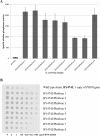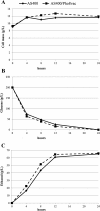Increased ethanol accumulation from glucose via reduction of ATP level in a recombinant strain of Saccharomyces cerevisiae overexpressing alkaline phosphatase
- PMID: 24884834
- PMCID: PMC4026825
- DOI: 10.1186/1472-6750-14-42
Increased ethanol accumulation from glucose via reduction of ATP level in a recombinant strain of Saccharomyces cerevisiae overexpressing alkaline phosphatase
Abstract
Background: The production of ethyl alcohol by fermentation represents the largest scale application of Saccharomyces cerevisiae in industrial biotechnology. Increased worldwide demand for fuel bioethanol is anticipated over the next decade and will exceed 200 billion liters from further expansions. Our working hypothesis was that the drop in ATP level in S. cerevisiae cells during alcoholic fermentation should lead to an increase in ethanol production (yield and productivity) with a greater amount of the utilized glucose converted to ethanol. Our approach to achieve this goal is to decrease the intracellular ATP level via increasing the unspecific alkaline phosphatase activity.
Results: Intact and truncated versions of the S. cerevisiae PHO8 gene coding for vacuolar or cytosolic forms of alkaline phosphatase were fused with the alcohol dehydrogenase gene (ADH1) promoter. The constructed expression cassettes used for transformation vectors also contained the dominant selective marker kanMX4 and S. cerevisiae δ-sequence to facilitate multicopy integration to the genome. Laboratory and industrial ethanol producing strains BY4742 and AS400 overexpressing vacuolar form of alkaline phosphatase were characterized by a slightly lowered intracellular ATP level and biomass accumulation and by an increase in ethanol productivity (13% and 7%) when compared to the parental strains. The strains expressing truncated cytosolic form of alkaline phosphatase showed a prolonged lag-phase, reduced biomass accumulation and a strong defect in ethanol production.
Conclusion: Overexpression of vacuolar alkaline phosphatase leads to an increased ethanol yield in S. cerevisiae.
Figures




Similar articles
-
Reduction of furan derivatives by overexpressing NADH-dependent Adh1 improves ethanol fermentation using xylose as sole carbon source with Saccharomyces cerevisiae harboring XR-XDH pathway.Appl Microbiol Biotechnol. 2013 Mar;97(6):2597-607. doi: 10.1007/s00253-012-4376-6. Epub 2012 Sep 22. Appl Microbiol Biotechnol. 2013. PMID: 23001007
-
Co-expression of TAL1 and ADH1 in recombinant xylose-fermenting Saccharomyces cerevisiae improves ethanol production from lignocellulosic hydrolysates in the presence of furfural.J Biosci Bioeng. 2014 Feb;117(2):165-169. doi: 10.1016/j.jbiosc.2013.07.007. Epub 2013 Aug 3. J Biosci Bioeng. 2014. PMID: 23916856
-
Development of a system for multicopy gene integration in Saccharomyces cerevisiae.J Microbiol Methods. 2016 Jan;120:44-9. doi: 10.1016/j.mimet.2015.10.023. Epub 2015 Oct 31. J Microbiol Methods. 2016. PMID: 26529647
-
The advances in creating Crabtree-negative Saccharomyces cerevisiae and the application for chemicals biosynthesis.FEMS Yeast Res. 2025 Jan 30;25:foaf014. doi: 10.1093/femsyr/foaf014. FEMS Yeast Res. 2025. PMID: 40121184 Free PMC article. Review.
-
Current Ethanol Production Requirements for the Yeast Saccharomyces cerevisiae.Int J Microbiol. 2022 Aug 13;2022:7878830. doi: 10.1155/2022/7878830. eCollection 2022. Int J Microbiol. 2022. PMID: 35996633 Free PMC article. Review.
Cited by
-
ATPase-based implementation of enforced ATP wasting in Saccharomyces cerevisiae for improved ethanol production.Biotechnol Biofuels. 2020 Nov 9;13(1):185. doi: 10.1186/s13068-020-01822-9. Biotechnol Biofuels. 2020. PMID: 33292464 Free PMC article.
-
Construction of advanced producers of first- and second-generation ethanol in Saccharomyces cerevisiae and selected species of non-conventional yeasts (Scheffersomyces stipitis, Ogataea polymorpha).J Ind Microbiol Biotechnol. 2020 Jan;47(1):109-132. doi: 10.1007/s10295-019-02242-x. Epub 2019 Oct 21. J Ind Microbiol Biotechnol. 2020. PMID: 31637550 Free PMC article. Review.
-
Improved Sugarcane-Based Fermentation Processes by an Industrial Fuel-Ethanol Yeast Strain.J Fungi (Basel). 2023 Jul 29;9(8):803. doi: 10.3390/jof9080803. J Fungi (Basel). 2023. PMID: 37623574 Free PMC article.
-
Pathway engineering strategies for improved product yield in yeast-based industrial ethanol production.Synth Syst Biotechnol. 2022 Jan 22;7(1):554-566. doi: 10.1016/j.synbio.2021.12.010. eCollection 2022 Mar. Synth Syst Biotechnol. 2022. PMID: 35128088 Free PMC article.
-
A transcriptome analysis of the ameliorate effect of Cyclocarya paliurus triterpenoids on ethanol stress in Saccharomyces cerevisiae.World J Microbiol Biotechnol. 2018 Nov 26;34(12):182. doi: 10.1007/s11274-018-2561-1. World J Microbiol Biotechnol. 2018. PMID: 30478689
References
-
- Renewable Fuels Association. Acelerating Industry Innovation – 2012 Ethanol Industry Outlook. Washington, DC: Renewable Fuels Association; 2012. pp. 3, 8, 10, 22–23.
-
- Ingledew WM. Alcohol production by Saccharomyces cerevisiae: a yeast primer, in the alcohol textbook. 3. UK: Nottingham University Press; 1999.
-
- Sprenger GA. Carbohydrate metabolism in Zymomonas mobilis: a catabolic highway with some scenic routes. FEMS Microbiol Lett. 1996;145:301–307. doi: 10.1111/j.1574-6968.1996.tb08593.x. - DOI
-
- Panesar PS, Marwaha SS, Kennedy JF. Zymomonas mobilis: an alternative ethanol producer. J Chem Technol Biotechnol. 2006;81:623–635. doi: 10.1002/jctb.1448. - DOI
Publication types
MeSH terms
Substances
LinkOut - more resources
Full Text Sources
Other Literature Sources
Molecular Biology Databases

